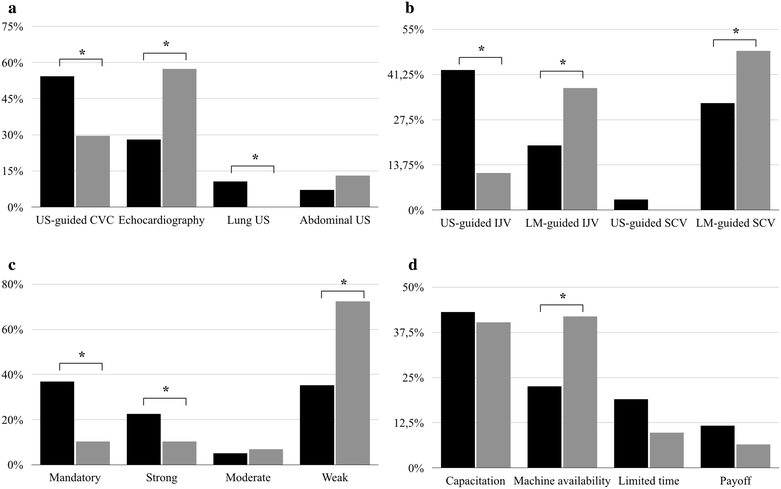Point-of-care ultrasonography in Brazilian intensive care units: a national survey
- PMID: 29808412
- PMCID: PMC5972134
- DOI: 10.1186/s13613-018-0397-3
Point-of-care ultrasonography in Brazilian intensive care units: a national survey
Abstract
Background: Point-of-care ultrasonography (POCUS) has recently become a useful tool that intensivists are incorporating into clinical practice. However, the incorporation of ultrasonography in critical care in developing countries is not straightforward.
Methods: Our objective was to investigate current practice and education regarding POCUS among Brazilian intensivists. A national survey was administered to Brazilian intensivists using an electronic questionnaire. Questions were selected by the Delphi method and assessed topics included organizational issues, POCUS technique and training patterns, machine availability, and main applications of POCUS in daily practice.
Results: Of 1533 intensivists who received the questionnaire, 322 responded from all of Brazil's regions. Two hundred and five (63.8%) reported having access to an ultrasound machine dedicated to the intensive care unit (ICU); however, this was more likely in university hospitals than in non-university hospitals (80.6 vs. 59.6%; risk ratio [RR] = 1.35 [1.16-1.58], p = 0.002). The main applications of POCUS were ultrasound-guided central vein catheterization (49.4%) and bedside echocardiographic assessment (33.9%). Two hundred and fifty-eight (80.0%) reported having at least one POCUS-trained intensivist in their staff (trained units). Trained units were more likely to perform routine ultrasound-guided jugular vein catheterization than non-trained units (38.6 vs. 16.4%; RR = 2.35 [1.31-4.23], p = 0.001). The proportion of POCUS-trained intensivists and availability of a dedicated ultrasound machine were both independently associated with performing ultrasound-guided jugular vein catheterization (RR = 1.91 [1.32-2.77], p = 0.001) and (RR = 2.20 [1.26-3.29], p = 0.005), respectively.
Conclusions: A significant proportion of Brazilian ICUs had at least one intensivist with POCUS capability in their staff. Although ultrasound-guided central vein catheterization constitutes the main application of POCUS, adherence to guideline recommendations is still suboptimal.
Keywords: Critical care; Survey; Ultrasonography.
Figures

Similar articles
-
Impact of an ultrasound-driven diagnostic protocol at early intensive-care stay: a randomized-controlled trial.Ultrasound J. 2019 Sep 30;11(1):24. doi: 10.1186/s13089-019-0139-2. Ultrasound J. 2019. PMID: 31595353 Free PMC article.
-
Point-of-care ultrasonography in Ukraine: a survey of anesthesiologists-intensivists participating in ultrasonography courses.Can J Anaesth. 2024 Oct;71(10):1379-1387. doi: 10.1007/s12630-024-02789-z. Epub 2024 Jun 25. Can J Anaesth. 2024. PMID: 38918272 English.
-
Assessment of Point-of-Care Ultrasound Training for Clinical Educators in Malawi, Tanzania and Uganda.Ultrasound Med Biol. 2019 Jun;45(6):1351-1357. doi: 10.1016/j.ultrasmedbio.2019.01.019. Epub 2019 Mar 21. Ultrasound Med Biol. 2019. PMID: 30904246
-
POCUS in the PICU: A Narrative Review of Evidence-Based Bedside Ultrasound Techniques Ready for Prime-Time in Pediatric Critical Care.J Intensive Care Med. 2025 Apr;40(4):372-378. doi: 10.1177/08850666231224391. Epub 2024 Jan 9. J Intensive Care Med. 2025. PMID: 38193214 Review.
-
Point-of-Care Ultrasound (POCUS) for the Cardiothoracic Anesthesiologist.J Cardiothorac Vasc Anesth. 2022 Apr;36(4):1132-1147. doi: 10.1053/j.jvca.2021.01.018. Epub 2021 Jan 16. J Cardiothorac Vasc Anesth. 2022. PMID: 33563532 Review.
Cited by
-
Comparison of the proximal and distal approaches for axillary vein catheterization under ultrasound guidance (PANDA) in cardiac surgery patients susceptible to bleeding: a randomized controlled trial.Ann Intensive Care. 2020 Jul 8;10(1):90. doi: 10.1186/s13613-020-00703-6. Ann Intensive Care. 2020. PMID: 32643012 Free PMC article.
-
Refusal of beds and triage of patients admitted to intensive care units in Brazil: a cross-sectional national survey.Rev Bras Ter Intensiva. 2022 Oct-Dec;34(4):484-491. doi: 10.5935/0103-507X.20220264-pt. Rev Bras Ter Intensiva. 2022. PMID: 36888829 Free PMC article.
-
Telemedicine ultrasound in intensive care unit: A pilot diagnostic accuracy study.Ultrasound. 2025 Feb;33(1):27-34. doi: 10.1177/1742271X241264178. Epub 2024 Jul 30. Ultrasound. 2025. PMID: 39555156 Free PMC article.
-
Use of bedside echocardiography in the care of critically ill patients - a joint consensus document of the Associação de Medicina Intensiva Brasileira, Associação Brasileira de Medicina de Emergência, and Sociedade Brasileira de Medicina Hospitalar. Part 1 - Competence in bedside echocardiography.Crit Care Sci. 2023 Mar 1;35(1):2-10. doi: 10.5935/2965-2774.20230307-en. Crit Care Sci. 2023. PMID: 37712724 Free PMC article.
-
The use of bedside echocardiography in the care of critically ill patients - a joint consensus document of the Associação de Medicina Intensiva Brasileira, Associação Brasileira de Medicina de Emergência and Sociedade Brasileira de Medicina Hospitalar. Part 2 - Technical aspects.Crit Care Sci. 2023 Apr-Jun;35(2):117-146. doi: 10.5935/2965-2774.20230310-en. Crit Care Sci. 2023. PMID: 37712802 Free PMC article.
References
-
- Frankel HL, Kirkpatrick AW, Elbarbary M, Blaivas M, Desai H, Evans D, et al. Guidelines for the appropriate use of bedside general and cardiac ultrasonography in the evaluation of critically ill patients—part I: general ultrasonography. Crit Care Med. 2015;43(11):2479–2502. doi: 10.1097/CCM.0000000000001216. - DOI - PubMed
-
- Levitov A, Frankel HL, Blaivas M, Kirkpatrick AW, Su E, Evans D, et al. Guidelines for the appropriate use of bedside general and cardiac ultrasonography in the evaluation of critically ill patients—part II: cardiac ultrasonography. Crit Care Med. 2016;44(6):1206–1227. doi: 10.1097/CCM.0000000000001847. - DOI - PubMed
LinkOut - more resources
Full Text Sources
Other Literature Sources

